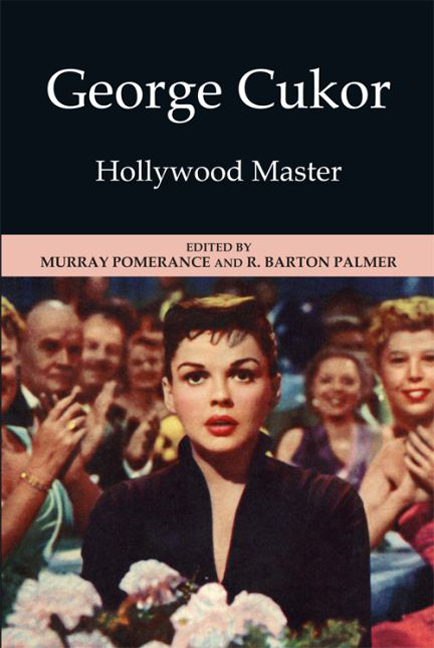Book contents
- Frontmatter
- Contents
- List of Figures
- List of Contributors
- Acknowledgments
- Introduction
- 1 Cukor's Tragicomedies of Marriage: Dinner at Eight, No More Ladies, The Women, and The Marrying Kind
- 2 George Cukor's Late Style: Justine, Travels With My Aunt, and Rich and Famous
- 3 Libel, Scandal, and Bad Big Names: It Should Happen to You, Les Girls, Camille, and Romeo and Juliet
- 4 The Cukor “Problem”: David Copperfield, Holiday, and The Philadelphia Story
- 5 Modulations of the Shot: The Quiet Film Style of George Cukor in What Price Hollywood?, Born Yesterday, Sylvia Scarlett, and My Fair Lady
- 6 Doubling in the Cinema of George Cukor: The Royal Family of Broadway, A Bill of Divorcement, A Double Life, and Bhowani Junction
- 7 George Cukor and the Case of an Actor's Director: Hepburn and/or Tracy in Little Women, The Actress, Keeper of the Flame, Adam's Rib, and Pat and Mike
- 8 Cukor Maudit: Tarnished Lady, Girls About Town, Our Betters, Susan and God, Desire Me, Edward, My Son, The Model and the Marriage Broker, Let's Make Love, and The Chapman Report
- 9 George Cukor's Theatrical Feminism: Gaslight, Heller in Pink Tights, A Life of Her Own, and A Star is Born
- 10 The Furthest Side of Paradise: Two-Faced Woman, A Woman's Face, Hot Spell, Wild is the Wind, and Winged Victory
- Works Cited and Consulted
- Index
Introduction
Published online by Cambridge University Press: 07 October 2017
- Frontmatter
- Contents
- List of Figures
- List of Contributors
- Acknowledgments
- Introduction
- 1 Cukor's Tragicomedies of Marriage: Dinner at Eight, No More Ladies, The Women, and The Marrying Kind
- 2 George Cukor's Late Style: Justine, Travels With My Aunt, and Rich and Famous
- 3 Libel, Scandal, and Bad Big Names: It Should Happen to You, Les Girls, Camille, and Romeo and Juliet
- 4 The Cukor “Problem”: David Copperfield, Holiday, and The Philadelphia Story
- 5 Modulations of the Shot: The Quiet Film Style of George Cukor in What Price Hollywood?, Born Yesterday, Sylvia Scarlett, and My Fair Lady
- 6 Doubling in the Cinema of George Cukor: The Royal Family of Broadway, A Bill of Divorcement, A Double Life, and Bhowani Junction
- 7 George Cukor and the Case of an Actor's Director: Hepburn and/or Tracy in Little Women, The Actress, Keeper of the Flame, Adam's Rib, and Pat and Mike
- 8 Cukor Maudit: Tarnished Lady, Girls About Town, Our Betters, Susan and God, Desire Me, Edward, My Son, The Model and the Marriage Broker, Let's Make Love, and The Chapman Report
- 9 George Cukor's Theatrical Feminism: Gaslight, Heller in Pink Tights, A Life of Her Own, and A Star is Born
- 10 The Furthest Side of Paradise: Two-Faced Woman, A Woman's Face, Hot Spell, Wild is the Wind, and Winged Victory
- Works Cited and Consulted
- Index
Summary
The Career
Hollywood's conversion to a sound cinema drew many of Broadway's brighter creative talents to filmmaking as the industry made the radical readjustment to producing a much more complex product. Pictures that talked were inherently more theatrical, requiring the mastery of a different set of skills on the part of performers and directors, who now had to work with something very similar to a play script. Among this distinguished company of New York City émigrés, none enjoyed a more consistently successful career in the new industrial art than George Cukor, who was twenty-nine years old when recruited by Paramount Pictures in 1928. Desperate for experienced help in this time of profound para¬digm shift, the studio even sent Cukor a plane ticket to the west coast because they were too impatient to await the young man's arrival in the more accepted fashion, by train. Paramount was certainly taking a chance on offering a direc¬tor's chair to someone barely acquainted with the inner workings of the new medium, no matter how successful he had been in his work for the commercial theater. And he had been successful. Showing business acumen early, as manager of one stock company and later co-founder of another, he was a natural on the stage. After a little acting he moved to the other side of the footlights, directing Melchior Lengyel's Antonia in 1925 (produced by Charles Frohman, with Georges Renavent), Owen Davis's The Great Gatsby in 1926 (with Florence Eldridge), Martin Brown's The Dark in 1927 (with Louis Calhern), Lula Vollmer's Trigger (with Claiborne Foster), Willard Mack's A Free Soul (with Melvyn Douglas), and Zoe Akins's The Furies (with Laurette Taylor) in 1928, and Samson Raphaelson's Young Love (with Dorothy Gish) and Maxwell Anderson's Gypsy (with Wallace Ford) in 1929, before departing for Hollywood.
But the differences between the stage and film had considerably narrowed. With the confining of most film productions to stage set interiors because of the exigencies of dialogue recording, then accomplished with bulky microphones, action scenes became a rarity in many genres, as filmgoer attention was directed toward the same carefully crafted verbal confrontations that were a Broadway staple.
- Type
- Chapter
- Information
- George CukorHollywood Master, pp. 1 - 10Publisher: Edinburgh University PressPrint publication year: 2015



